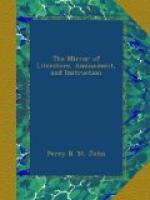“They always face in one direction, standing nearly side by side, and are not able, without inconvenience, to face in the opposite direction—so that one is always at the right, and the other at the left. Although not placed exactly in a parallel line, they are able to run and leap with surprising activity. On some occasions a gentleman, in sport, pursued them round the ship, when they came suddenly to the hatchway, which had been inadvertently left open. The least check would have thrown them down the hatchway, and probably killed one, or both, but they leaped over it without difficulty. They differ in intellectual vigour; the perceptions of one are more acute than those of the other, and there is a corresponding coincidence in moral qualities. He who appears most intelligent is somewhat irritable in temper, while the other’s disposition is mild.”
The connexion between these boys might present an opportunity for some interesting observations in regard to physiology and pathology. There is, no doubt, a network of blood-vessels and some minute nerves passing from one to the other. How far these parts are capable of transmitting the action of medicines, and of diseases, and especially what medicines and diseases, are points well worthy of consideration. Dr. W. thinks that any indisposition of one extends to the other; that they are inclined to sleep at the same time; eat about the same quantity, and perform other acts with great similarity. Both he and Mr. Hunter are of opinion that touching one of them when they are asleep, awakens both. When they are awake, an impulse given to one does not in the least affect the other. There is evidently no impression received by him who is not touched. But the opinion just mentioned is undoubtedly erroneous. The slightest movement of one is so speedily perceived by the other, as to deceive those who have not observed closely. There is no part of them which has a common perception, excepting the middle of the connecting cord, and a space near it. When a pointed instrument is applied precisely to the middle of the cord, it is felt by both, and also for about an inch on each side; beyond which the impression is limited to the individual of the side touched.
“In the function of the circulation there is a remarkable uniformity in the two bodies. The pulsations of the hearts of both coincide exactly under ordinary circumstances. I counted seventy-three pulsations in a minute while they were sitting—counting first in one boy and then in the other; I then placed my fingers on an arm of each boy, and found the pulsations take place exactly together. One of them stooping suddenly to look at my watch, his pulse became much quicker than that of the other; but after he had returned to his former posture, in about a quarter of a minute his pulse was precisely like that of the other; this happened repeatedly. Their respirations are, of consequence, exactly simultaneous.”




